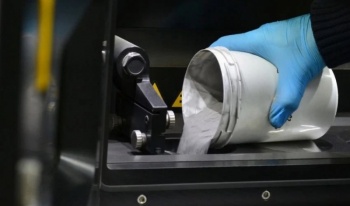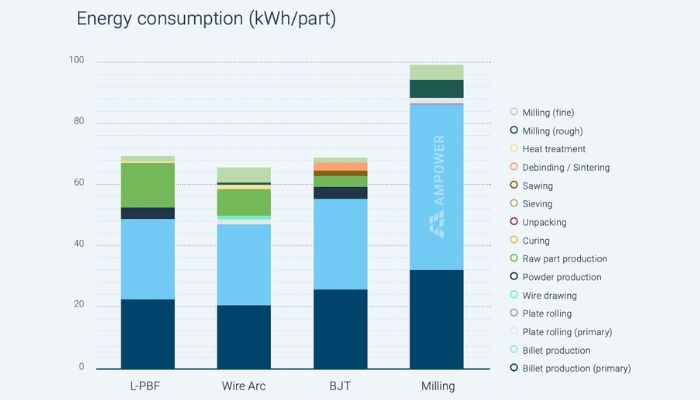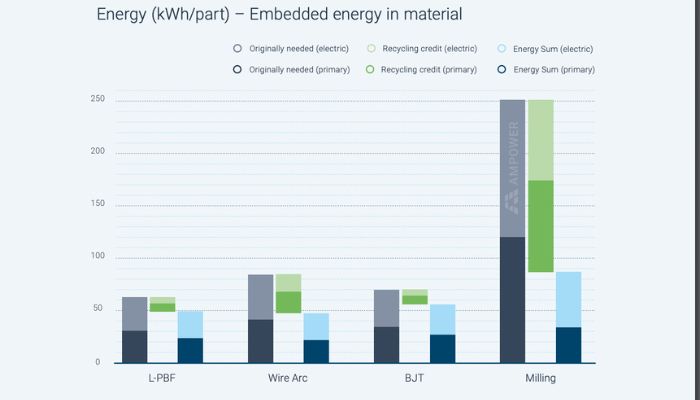
We have known for a while that sustainability is a key benefit of additive manufacturing. There are already many examples of this: for example, in architecture, all kinds of consumer goods, and even lithium batteries. A recently published report now provides specific information on sustainability when it comes to metal additive manufacturing along the entire value chain. Specifically, this analysis addresses key questions of sustainability in additive manufacturing compared to traditional methods, such as the factors which ensure a lower carbon footprint and how users can achieve their personal or corporate CO2 goals thanks to additive manufacturing. We have taken a closer look at the results of the report here.
Looking back over the past decades, the ever-increasing CO2 in our atmosphere and the underlying consequences for people, nature and the planet are truly worrying. To help companies directly reduce their carbon footprint, additive manufacturing has increasingly been coming into play throughout the production cycle. To assess sustainability, AMPOWER has designed a calculator to evaluate the CO2 footprint of different technologies. This has produced quantitative evidence that the CO2 emissions of Powder Bed Fusion are significantly lower than those of milling. The reason for this is that weight-optimized constructions can be produced by the former method and therefore the material and energy input are lower. Binder jetting, which has low emissions throughout its process from 3D printing to debinding, performed surprisingly well.

The detailed energy consumption for each step of several methods.
Achieving Sustainability Through Additive Manufacturing
An important point to consider when it comes to sustainability is the different types of energy used in production. For example, other industrial processes and manufacturing technologies – casting for example – generate heat and therefore direct CO2 emissions by burning fossil fuels. In contrast, additive manufacturing of metals uses only electrical energy, which means that this required energy results in a different amount of carbon emissions.
If we look at the entire value chain of metal additive manufacturing, sustainability starts with the material requirement; the exact amount of raw material needed. As far as the subsequent recycling of the material is concerned, the proportion of recycled material is relatively high, which is additionally helped by new processes for the production of 100% recyclable metal powders. Also with regard to the possibility of “on-demand production”, a considerable part of the CO2 emissions can be saved through this method, because it minimizes the required storage capacities as well as transport requirements. In addition, in terms of sustainability in the course of metal production, increased product efficiency should be considered. Through the optimization of weight and performance, the efficiency of parts such as turbines, hydraulics, aircraft or even automobiles can be increased. This results in energy savings over the entire service life of the additively manufactured part.
Which Technology Is the Most Sustainable?
According to the AMPOWER report, it is very difficult to say which type of production has the lowest carbon emissions. Why? Because it depends very much on the alloy group as well as the part geometry. In simple terms, this means that complex geometries have the lowest carbon footprint when manufactured using AM, whereas simple parts are the most sustainable when milled. Regarding the sustainability calculator and taking an aircraft part as an example, weight is often directly related to the fuel required and therefore CO2 emissions generated. If weight can be reduced so too can be the resulting fuel consumption. In aviation, an annual value of 2,500 liters of kerosene is calculated per kilogram of weight saved. If we assume that an aircraft part has a service life of around 20 years, this means that up to 50,000 liters of kerosene or 126,000 kilograms of CO2 can be saved per kilogram of weight saved per aircraft. If you would also like to use the sustainability calculator for additive metal manufacturing, you can find more information on purchasing and downloading HERE.

Net energy use for different methods of metal additive manufacturing when recycled energy is accounted for.
*All photo credits: AMPOWER



